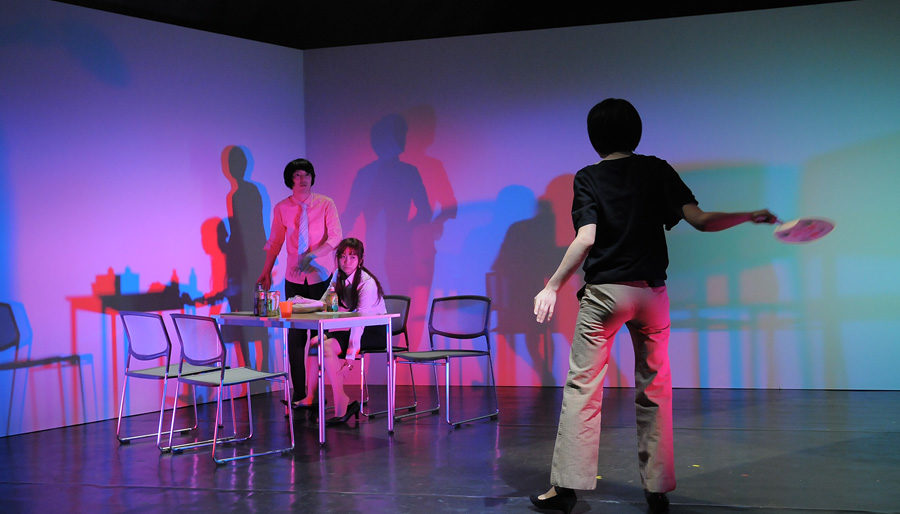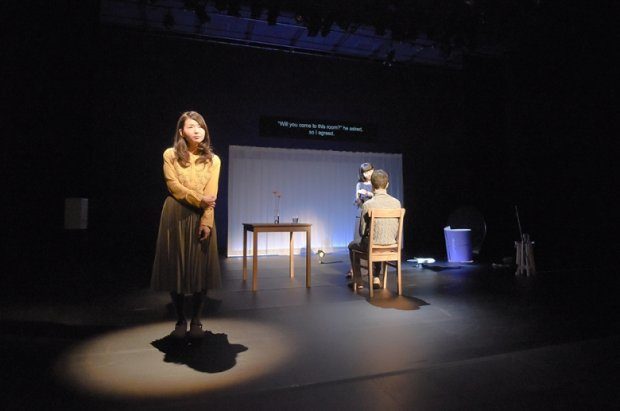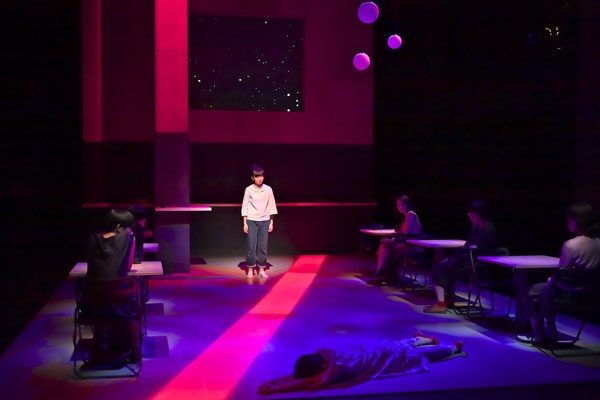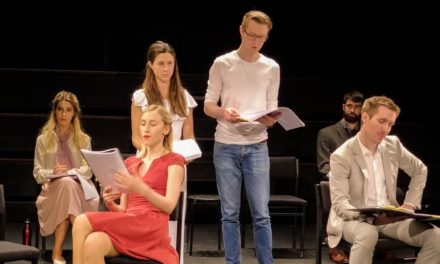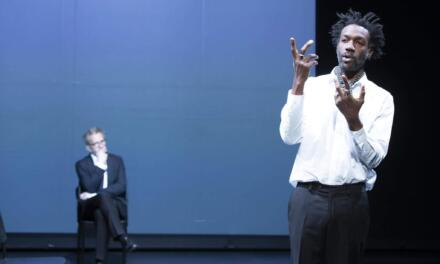In May 2016, Japanese writer and director Toshiki Okada presented his latest production, Time’s Journey Through a Room, at the Kunstenfestivaldesarts in Brussels. It immerses the audience in an altered experience of time. In Okada’s theatre, past, present and future are interlaced. He experiments with heterochronic time in order to question what it means to live in the ‘now.’
In the opening scene of Time’s Journey Through a Room (2016), Toshiki Okada’s most recent theatre production, an actress informs us with a Brechtian gesture of what is to come. “I will step into this room and become this man’s lover, later, slowly.” She walks off the stage but will return periodically to give us an update on the status of her journey to the man’s apartment. The bus she is on is stuck in Tokyo traffic. She describes the car accident that causes her delay in a manner reminiscent of the model for the epic theatre Brecht lays out in ‘The Street Scene.’ But first, she asks us to close our eyes. When we open them again, we have returned to the year 2012.
A man sits, immobilized, with his back to the audience nearly the entire duration of the play, uncomfortably fidgeting in his chair, rubbing his legs. He is joined by the ghost of his wife, Honoka. Gesticulating equally awkwardly, she takes him back in time and calls on him to remember the last days they spent together. She speaks of her hopes for the future and the strong sense of solidarity immediately following the devastating earthquake that hit northern Japan on March 11, 2011. The man tries to resist her persistent calls. In silence, he anticipates the arrival of his new lover, Alisa. He is caught in between past and present, and between two contrasting visions for the future. Both his deceased wife’s pleas to return to the past, and the here and now that literally closes in on him are impossible to bear.
Time’s Journey Through a Room calls attention to the significance of timing and rhythm, time and history to Okada’s oeuvre. Since he established his theatre company chelfitsch (a playful mis-spelling of the English selfish) in 1997, he produced more than fifteen plays. Okada has become a regular guest at theaters and festivals abroad, an experience that inspires him and influences his work. At the same time, his plays continue to be rooted in his personal experiences living and working in Japan. They critically reflect on the specificities of everyday life in Tokyo, the socio-economic and political situation in Japan today, and the artist’s own position within the Japanese contemporary theatre scene. What makes his work so unique is the astute way in which it captures the times. The title of this essay indeed refers to what is at stake in all of Okada’s work, namely to question what it means to be in the ‘now’ and how to adequately articulate this in (his) theatre.
In addition, I borrowed my title from a short essay by Jacques Rancière, In What Time Do We Live?, in which the French philosopher explores what political art might look like in these post-historical times. Time, he argues, has become disconnected from possibility. Since the end of history and the conventional linear historical narrative, the future no longer necessarily holds any promises for change, better alternatives, or revolution. The only way in which art can be political at this particular conjuncture, Rancière maintains, is by representing time as heterochronical or as a “montage of times.” [i] This coming together of incompatible temporalities, is, as Peter Osborne argues in Anywhere or Not at All, characteristic of the contemporary moment. The contemporary does not merely refer, Osborne states, to art that is up to date or to a period in art history, but also to our current “condition,” which is characterized precisely by the coming together of different temporalities in the present. Terry Smith similarly defines the contemporary as “being with time (con tempus), that is to say, with many times at the same time.’”[ii]
Rancière’s analysis resonates in particular with Okada’s most recent plays, which explicitly explore this sense of loss of possibility for the future, exacerbated still in post-Fukushima Japan. Time’s Journey through a Room is his third play about the aftermath of the so-called triple disaster, after Current Location (2012) and Ground and Floor (2013). In his most recent play, each character experiences the passing of time differently and takes a very different stance vis-a-vis the past, the present, and the future. The action on stage is decelerated to such an extent that the audience too is pulled into an alternative experience of time. Today’s Japan is characterized by an overwhelming sense of anxiety, not only in relation to the insecure socio-economic situation but also with the physical safety and the health of future generations. The idea of the future itself appears to have lost its meaning.
Alienation
The plight of the so-called Lost Generation, to which the artist himself belongs, is a recurrent theme in Okada’s work. This generation grew up in the 1980s and entered the workforce in the 1990s when Japan’s exceptional postwar economic growth came to a sudden halt and familiar structures and institutions collapsed. This resulted in precarious labor and social conditions. Upon graduation, many young people found themselves in temporary or underpaid part-time jobs, and living in tiny apartments, with their parents (parasite singles), or even in manga cafes. For a while, the so-called freeters and NEET lived parallel lives, outside of the mainstream, while the generation of their parents was still firmly embedded in the established system. Otaku and hikikomori too initially shut themselves off from society as an act of resistance against the stifling Japanese education and work culture. They were looking for alternative ways to organize their time and to engage with the reality of everyday life. However, as the recession continues, the country is facing a steady increase in unemployment and homelessness, also among older generations. Contrary to the discourse propagated in his school textbooks, Okada points out, Japan was exposed as a class society after all, and poverty and discrimination are becoming increasingly visible. The circumstances became more severe after March 11, 2011.
Okada’s plays are set in the offices (Hot Pepper, Air Conditioner and the Farewell Speech, 2009), convenience stores (Super Premium Soft Double Vanilla Rich, 2015) and family restaurants (Freetime, 2008) where Japan’s youth is employed under deplorable circumstances. They provocatively visualize the ways in which the artist’s generation feels out of sync with mainstream, normative society. His successful play Five Days in March (2004) explores the Lost Generation’s refusal to participate in society as a political gesture. In an interview, Okada describes the attitude of Japanese youth vis-a-vis the world as ‘concern with some degree of distance.’ [iii] Alienation in his work operates as a central theme as well as an aesthetic strategy.
Five Days in March talks about Minobe and Yukki, who end up at a love hotel in Shibuya after meeting at a concert in a Tokyo club. Oblivious to what is going on in the outside world, they spend five days in a room together. They have sex day in and day out, forget to eat, don’t watch TV, and completely lose track of time. When their money runs out, they separate at the station, without exchanging names or contact information. All this while the war in Iraq breaks out and anti-war demonstrations are popping up around the capital.
The characters are all, in one way or other, stuck in their own space and time, and attempt to evade reality. After leaving the same club, another character, a young female otaku who calls herself Miffie, locks herself up in her bedroom at her parents’ house, and fantasizes about escaping to Mars. In the meantime, two young men accidentally end up in, and wander in and out of, an anti-war march, albeit, they point out, in the relatively disengaged tail end of it. The play shows a group of young Tokyoites not sure about how to engage with the world. They have little interest in other people, relationships, the war, or the anti-war movement. They hold no (steady) jobs and have trouble committing to anyone or anything.
The language Okada develops in Five Days in March embodies the genuinely precarious situations in which his protagonists find themselves as well as their detachment from the world. On the chelfitsch website, Okada’s unique style is described as the combination of “super-real Japanese” and a “sluggish, noisy corporeality.” He writes in the vernacular of Japanese youth, which he pushed to its limits, and experiments with a unique movement vocabulary inspired by the typical gestures and behavior of teenagers in the shopping districts of Tokyo.[iv]
The characters often ramble on, don’t finish their thoughts, frequently interrupt one another, and jump from one topic to the next. Okada shows these youngsters in awkward postures, as if in the process of figuring out what to say, how to express themselves or make a connection with what goes on around them. The performers are often fidgeting, nervously pulling at their clothes, touching an arm or a leg, and trying to find firm footing, a sense of balance. Their body language emanates boredom, passivity, and apathy. The uncanny disjunction between their words and gestures stresses the anxiety, the physical and mental fragility that emanates from these characters. However, their actions also embody the subtle resistance and performativity characteristic of the behavior of Shibuya and Harajuku hipsters, ‘loosening’ their comportment, their language, and their fashion, as a reaction against the impeccably straight demeanor that typifies mainstream Japan. They hang around, squat on the sidewalks, wear much too big and too loose knee-high socks, and extreme make-up. This collapse of language and posture and Okada’s radical desynchronisation of words and gestures are both a metaphor for the insecure situation this generation finds itself in and a recording of expected corporeality and composure. The behavior of the men and women in Five Days in March hovers uncomfortably between action and inertia, rebelling and retreating, a tension that is present in all of Okada’s plays.
Politics and Desynchronization
Okada’s work is not only rooted in the local, in the current state of Japanese society, but also in Japanese theatre history. His plays examine specifically the ways in which his predecessors introduced the political into the theatre and reflect on experiments with Brechtian epic theatre, socialist realism, and physical theatre by the Japanese avant-garde of the 1960s and 70s. However, he is particularly inspired by the dramatic theory developed by playwright and director Oriza Hirata (1962) and his theatre company Seinendan in the early 1990s.
Hirata’s Contemporary Colloquial Theatre, which was quickly dubbed “Quiet Theatre” by the Japanese media, involved a radical shift in the time and rhythm of a performance and starts from a separation of the actors’ words and gestures. Situations are revealed gradually, indirectly, and in real time, with a minimum of dialogue and action. Hirata’s carefully crafted scripts are written in everyday spoken Japanese, using a sparing number of words and an abundance of punctuation to secure ample space for hums, nods, and other kinds of nonverbal communication. His project, which later found echoes in national politics, education, and robotics, started out as a reaction against the conventional modern theater (shingeki) in Japan, which was characterized by literary, often translated, dramatic texts and an artificial looking, psychological acting style. In addition, Hirata aimed to free the theater of the ideology that, he argues, was part and parcel of shingeki as well as of the angura (underground) theatre of the 1960s and 70s. His innovative methodology offered young artists new tools to address pressing local and global issues by homing in on the countless micronarratives and histories that intertwine in everyday life.
Okada’s method draws particularly on the acting technique Hirata developed and to which he refers as “split consciousness.” Hirata requires his actors to focus on an object, a gesture, or their position in relation to the other actors on the stage when speaking their lines, rather than on the words spoken. This technique, he argues, liberates actors from expressing emotions or playing a part, and makes them appear more natural. For the same reason, he makes frequent use of indirect speech, including hearsay and rumors. In Five Days in March Okada maximizes this approach. [v]
Okada effectively staggers words and gestures and overstresses the glitches, (involuntary) movements, and awkward postures people tend to produce while speaking. He probes the boundary where common patterns of speech and gesture turn strange. Rather than to split their “consciousness,” or their focus, between spoken lines and bodily movements, he asks his performers to concentrate on the image or idea that, he asserts, comes before both words and gestures. ‘[T]here must be something within the human being that precedes the script or bodily expression. When you say something or make a gesture there must be some underlying reason, something inside that is the origin. That is where I want to take the consciousness.’ [vi] During rehearsals, the performers generate a movement vocabulary based on such images. While these movements are subsequently fixed, they have to be performed each time as if they were improvised. To do this, the actors continue to return to the initial image while performing.
While these gestures are never completely disconnected from the script, they by no means illustrate the words. The corporeality is awkward but there is an authenticity to it. Movements reference everyday actions and are bound up with the individuality of the performer. By desynchronising speech and gesture, Okada puts into relief both aspects of communication, and calls attention to the indissoluble connection between them as well as to the power language tends to exercise over the body.
For Okada, this approach in the first place reflects reality. He posits that we are not very articulate in everyday life and that our words and gestures rarely directly correspond. However, there is a sense of excess in both. Words keep on coming in an unstoppable flow, and sentences remain unformed or unfinished. Gestures are blown up, disproportionate, and mismatched. This slippage produces an uncanny and humorous effect, as well as an attractive and fascinating rhythm.
Okada quotes common gestures as a tool to reflect on Japan today. He shares this approach with Japanese contemporary choreographers, who often find inspiration for movement material in the traces everyday life in hectic, overpopulated Tokyo leaves on the body. In fact, his work was first noticed by dance critics. Okada regularly collaborates with choreographers and dancers, explores the boundary between his unique performance style and dance, and often works with (live) music.
chelfitsch sets itself apart in the way in which it separates and juxtaposes the different elements of a theatre production, including text, movement, music, light, and set. Okada also introduces a distance between the characters, who hardly communicate with each other, and between the performers and the roles they play. It is in this context that we must also situate the persistent influence of Brecht’s epic theatre on his oeuvre. Okada draws extensively on the Brechtian gestus and alienation effect to question the distance between the actors and the audience, and to visualize the gap between the youth of his generation and politics.
The seven performers in Five Days in March step in and out of character, switch roles, and regularly address the audience directly – to comment on the story or the action, or to announce what is yet to come. The script is extremely cut up. Storylines meander, are repeated and are frequently interrupted for endless digressions and detours. The story of Minobe and Yukki is shared by all of the actors, who alternately step onto the stage in different configurations, re-enact parts of their adventure, tell others what they have heard, and correct or bud into each other’s account of the events. The relationships between the characters only gradually become visible, and we are presented with the same story from different points of view.
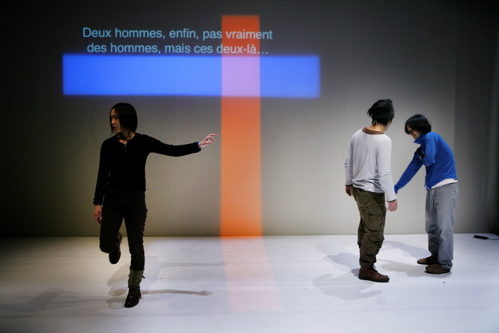
Five Days in March. Rukino Yamazaki, Eiji Takigawa, Taichi Yamagata 5/07 Paris. Photo © & courtesy of Thomas Bremond
Writing in the vernacular of contemporary Japanese youth, traditionally considered ‘poor,’ is a political gesture. Okada takes this usage of the Japanese language, which is his own, seriously. In this way, he gives a voice to subcultures generally ignored or muted, and to a whole generation deemed ‘lost.’ I read his attentiveness to the materiality of bodies and gestures on the stage in the same way. By desynchronizing voice and body, new levels of meaning emerge.
In addition, his recent work introduces the dead. This too is part of his strategy to make the invisible visible, to make alternative voices heard and other histories visible. Hirata writes that the Japanese theater since the 1990s differs from its predecessors in that it is genuinely concerned with the other and reflects on its context. [vii] Okada expands this idea by addressing his theatre to the invisible other: he includes as part of his audience not only people from the past but also generations still to come.
Japan after Fukushima
Time’s Journey Through a Room (2016) is the third play in which Toshiki Okada takes on the subject of the March 11, 2011 earthquake and its catastrophic aftermath. It addresses the impossibility to move on from an event the effects of which are invisible but life-threatening, continue to linger and will do so for an undetermined period of time. Okada carefully composes a complex temporal texture by layering and juxtaposing diverging times and temporalities. The result effectively transforms the audience’s perception of time.
We experience the unbearable sense of powerlessness that takes hold of the play’s three characters, as they struggle to resist the pressures of time and history. The protagonist, a man who lost his wife to an acute asthma attack soon after the quake, remains mute and immobile nearly the entire time. He finds himself literally at the intersection between the trajectories marked by the two female characters. Alisa moves minimally, in the here and now. She tries to make her way to see the man with whom she wants to start a new life, slowly, eventually, at her own pace. Honoka, his wife’s talkative ghost, however, moves incessantly and much more energetically. She takes him back in time, to their last days together, and to the moment immediately following the disaster, which radically changed her. She had been ‘reborn’ and became hopeful about the future again. Her ideals for a better world sound painfully out of sync, however, with the world that has already gone back to normal, as if nothing has changed, and where the notion of the future itself has been evacuated of meaning. At the end of the play, the man and his new girlfriend, finally united, appear frozen in time. Like a tableau, they sit at the table in silence, tentatively holding hands.
There is a sense of untimeliness to all of the characters in the play. They appear somehow outside of time, resist it, close themselves off from the passing of time. They are stuck in their own moment and unable to meaningfully engage with the present. We are witnesses to a gesture of mourning and the temporal experience associated with repeatedly returning to the moment of a trauma in order to overcome it. This is a movement Okada himself repeats, as he continues to revisit this subject matter, to reflect on it from different perspectives.
In all three pieces set in post-Fukushima Japan, the question of ‘moving on’ from what happened is linked to physically distancing oneself, ‘moving away.’ Is one to stay to take responsibility, or to leave, to secure one’s own safety? To underwrite the dominant narrative of national solidarity or to refuse to accept the doctrine? To succumb to the demands of family and society or to explore one’s own strategy to cope?
Okada, who moved with his wife and children to the south of Japan, as far away from the radiation as possible, addresses similar issues in Time’s Journey Through a Room (2016), Current Location (2012), and Ground and Floor (2013). The latter play explores the different positions taken by two brothers in relation to the calls of the ghost of their deceased mother to honor her wishes and stay put in a toxic environment. In this play too Okada questions the idea of Japanese identity, the meaning of the nation, and the role of the government (which remained reticent about the real consequences of the catastrophe) by juxtaposing contrasting positions and responses.
In Ground and Floor as well as in Time’s Journey Through a Room, Okada introduces the ghost of a deceased family member. In this way, he includes history and the past in the here and now of the performance and accounts for the increasing merging, layering, and intersecting of non-synchronous times in Japanese society today. Okada calls on ghosts, who, he says, like actors, only exist when they are seen, when there is a witness, to actualize the past differently in the present. The manner in which he portrays contemporary Japan resonates with what Italian philosopher Giorgio Agamben describes as dys-chrony: a disconnect with the present characteristic of the contemporary, of contemporariness.[viii] By introducing the spectral, the non-synchronicity of different co-existing times, temporalities, rhythms, and narratives is further underscored. Time’s Journey Through a Room shows what Peter Osborne describes as the disjunctive conjunction of temporalities characteristic of the contemporary, heightened, however, by the consequences of the earthquake, tsunami, and nuclear meltdown.[ix] Toshiki Okada takes on the urgency in post-Fukushima Japan to not only critically represent the ‘now’ but also radically re-think the present, the past and the future.
The original article “What time are we living?” Time and Distance in the Work of Toshiki Okada appeared in the September edition of Etcetera. Reposted with the kind permission of Etcetera.
Translated from Dutch into English by Sara Jansen.
Notes:
[i] Rancière, Jacques, “In What Time Do We Live?” in The State of Things, Koenig Books, Londen, 2012, p. 36.
[ii] Smith, Terry and Saloni Mattur, “Contemporary Art: World Currents in Transition Beyond Globalization,” in Contemporaneity: Historical Presence in Visual Culture, vol. 3, nr. 1, p. 168.
[iii] “Artist Interview: The Adventurous World of Toshiki Okada, a Playwright Who Writes in ‘Super-Real’ Japanese,” http://performingarts.jp/E/art_interview/0510/1.html
[V] Hirata, Oriza, Gendai Kogo Engeki No Tame Ni, Banseisha, Tokyo, 1995.
[vi] “Artist Interview: The Adventurous World of Toshiki Okada, a Playwright Who Writes in ‘Super-Real’ Japanese,” http://performingarts.jp/E/art_interview/0510/1.html
[Vii] Hirata, Oriza, Engeki Nyumon, Kodansha, Tokyo, 1998 .
[viii] Agamben, Giorgio, “What Is the Contemporary?” in ‘What Is an Apparatus?’ and Other Essays, Stanford University Press, California, 2009, p. 41.
[ix] Osborne, Peter, Anywhere or Not at All: Philosophy of Contemporary Art, Verso Books, Londen, 2013, p. 17
This post was written by the author in their personal capacity.The opinions expressed in this article are the author’s own and do not reflect the view of The Theatre Times, their staff or collaborators.
This post was written by Sara Jansen.
The views expressed here belong to the author and do not necessarily reflect our views and opinions.

